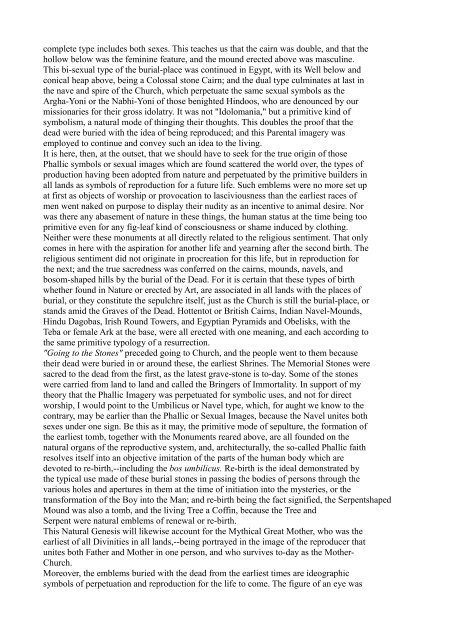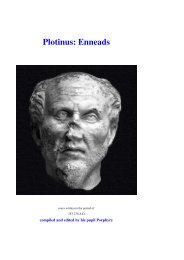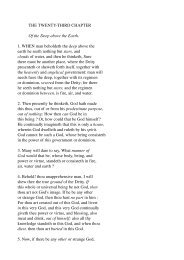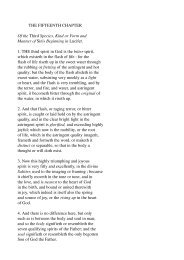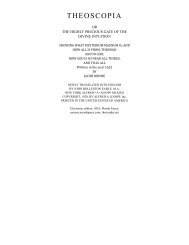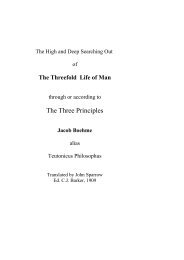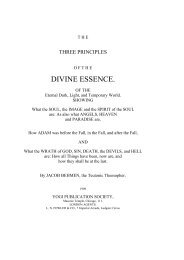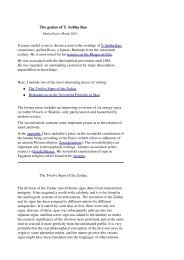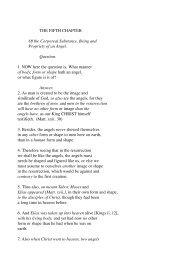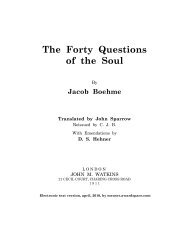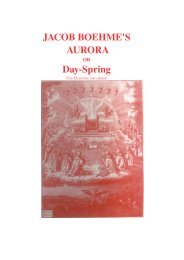Gerald Massey's Lectures - Society in evolution - Awardspace
Gerald Massey's Lectures - Society in evolution - Awardspace
Gerald Massey's Lectures - Society in evolution - Awardspace
You also want an ePaper? Increase the reach of your titles
YUMPU automatically turns print PDFs into web optimized ePapers that Google loves.
complete type <strong>in</strong>cludes both sexes. This teaches us that the cairn was double, and that the<br />
hollow below was the fem<strong>in</strong><strong>in</strong>e feature, and the mound erected above was mascul<strong>in</strong>e.<br />
This bi-sexual type of the burial-place was cont<strong>in</strong>ued <strong>in</strong> Egypt, with its Well below and<br />
conical heap above, be<strong>in</strong>g a Colossal stone Cairn; and the dual type culm<strong>in</strong>ates at last <strong>in</strong><br />
the nave and spire of the Church, which perpetuate the same sexual symbols as the<br />
Argha-Yoni or the Nabhi-Yoni of those benighted H<strong>in</strong>doos, who are denounced by our<br />
missionaries for their gross idolatry. It was not "Idolomania," but a primitive k<strong>in</strong>d of<br />
symbolism, a natural mode of th<strong>in</strong>g<strong>in</strong>g their thoughts. This doubles the proof that the<br />
dead were buried with the idea of be<strong>in</strong>g reproduced; and this Parental imagery was<br />
employed to cont<strong>in</strong>ue and convey such an idea to the liv<strong>in</strong>g.<br />
It is here, then, at the outset, that we should have to seek for the true orig<strong>in</strong> of those<br />
Phallic symbols or sexual images which are found scattered the world over, the types of<br />
production hav<strong>in</strong>g been adopted from nature and perpetuated by the primitive builders <strong>in</strong><br />
all lands as symbols of reproduction for a future life. Such emblems were no more set up<br />
at first as objects of worship or provocation to lasciviousness than the earliest races of<br />
men went naked on purpose to display their nudity as an <strong>in</strong>centive to animal desire. Nor<br />
was there any abasement of nature <strong>in</strong> these th<strong>in</strong>gs, the human status at the time be<strong>in</strong>g too<br />
primitive even for any fig-leaf k<strong>in</strong>d of consciousness or shame <strong>in</strong>duced by cloth<strong>in</strong>g.<br />
Neither were these monuments at all directly related to the religious sentiment. That only<br />
comes <strong>in</strong> here with the aspiration for another life and yearn<strong>in</strong>g after the second birth. The<br />
religious sentiment did not orig<strong>in</strong>ate <strong>in</strong> procreation for this life, but <strong>in</strong> reproduction for<br />
the next; and the true sacredness was conferred on the cairns, mounds, navels, and<br />
bosom-shaped hills by the burial of the Dead. For it is certa<strong>in</strong> that these types of birth<br />
whether found <strong>in</strong> Nature or erected by Art, are associated <strong>in</strong> all lands with the places of<br />
burial, or they constitute the sepulchre itself, just as the Church is still the burial-place, or<br />
stands amid the Graves of the Dead. Hottentot or British Cairns, Indian Navel-Mounds,<br />
H<strong>in</strong>du Dagobas, Irish Round Towers, and Egyptian Pyramids and Obelisks, with the<br />
Teba or female Ark at the base, were all erected with one mean<strong>in</strong>g, and each accord<strong>in</strong>g to<br />
the same primitive typology of a resurrection.<br />
"Go<strong>in</strong>g to the Stones" preceded go<strong>in</strong>g to Church, and the people went to them because<br />
their dead were buried <strong>in</strong> or around these, the earliest Shr<strong>in</strong>es. The Memorial Stones were<br />
sacred to the dead from the first, as the latest grave-stone is to-day. Some of the stones<br />
were carried from land to land and called the Br<strong>in</strong>gers of Immortality. In support of my<br />
theory that the Phallic Imagery was perpetuated for symbolic uses, and not for direct<br />
worship, I would po<strong>in</strong>t to the Umbilicus or Navel type, which, for aught we know to the<br />
contrary, may be earlier than the Phallic or Sexual Images, because the Navel unites both<br />
sexes under one sign. Be this as it may, the primitive mode of sepulture, the formation of<br />
the earliest tomb, together with the Monuments reared above, are all founded on the<br />
natural organs of the reproductive system, and, architecturally, the so-called Phallic faith<br />
resolves itself <strong>in</strong>to an objective imitation of the parts of the human body which are<br />
devoted to re-birth,--<strong>in</strong>clud<strong>in</strong>g the bos umbilicus. Re-birth is the ideal demonstrated by<br />
the typical use made of these burial stones <strong>in</strong> pass<strong>in</strong>g the bodies of persons through the<br />
various holes and apertures <strong>in</strong> them at the time of <strong>in</strong>itiation <strong>in</strong>to the mysteries, or the<br />
transformation of the Boy <strong>in</strong>to the Man; and re-birth be<strong>in</strong>g the fact signified, the Serpentshaped<br />
Mound was also a tomb, and the liv<strong>in</strong>g Tree a Coff<strong>in</strong>, because the Tree and<br />
Serpent were natural emblems of renewal or re-birth.<br />
This Natural Genesis will likewise account for the Mythical Great Mother, who was the<br />
earliest of all Div<strong>in</strong>ities <strong>in</strong> all lands,--be<strong>in</strong>g portrayed <strong>in</strong> the image of the reproducer that<br />
unites both Father and Mother <strong>in</strong> one person, and who survives to-day as the Mother-<br />
Church.<br />
Moreover, the emblems buried with the dead from the earliest times are ideographic<br />
symbols of perpetuation and reproduction for the life to come. The figure of an eye was


